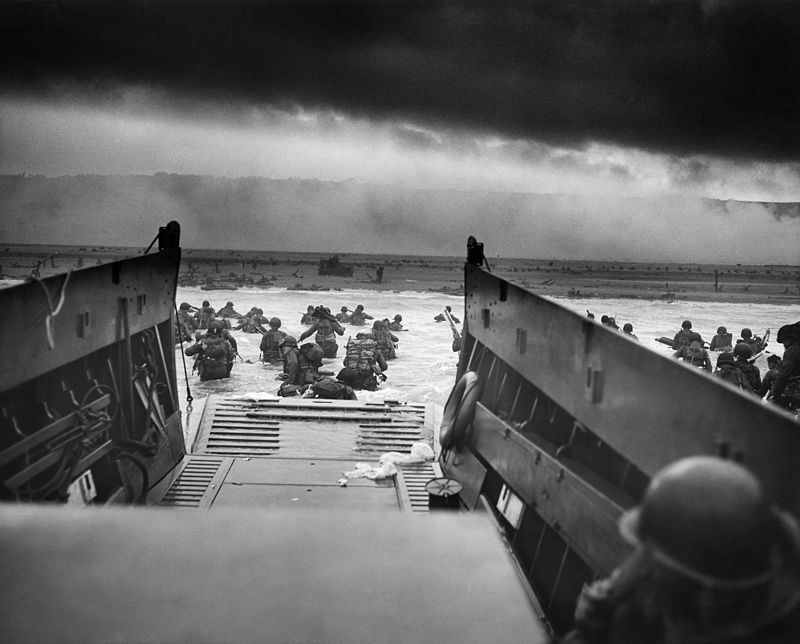Today, when things go terribly wrong. The Honors College at the University of Houston presents this program about the machines that make our civilization run, and the people whose ingenuity created them.
June 6, 1944 was just a Tuesday to most people; but for thousands in on the biggest secret of the year, it was D-Day: the largest seaborne invasion in history. We celebrate this day as one of the greatest achievements of the Allied war effort. It was massive on every level. It combined the Allies' industrial strength, the inventiveness of their military engineers and planners, and the coordination of all branches of service on land, sea, and air.
But if you've seen the film Saving Private Ryan, you'll know that for the men in the first waves, particularly on the American sector called Omaha Beach, it felt nothing like success. It was a terrifying maelstrom of chaos and death. All the careful planning, specially designed vehicles, and months of training couldn't save the thousands of men who lost their lives that morning. Planes dropped 13,000 bombs before the landing: they completely missed their targets; intense naval bombardment still failed to destroy German emplacements. The result was, Omaha Beach became a horrific killing zone, with the wounded left to drown in the rising tide.

Photo taken by Robert F. Sargent on D-Day. Two thirds of the unit seen disembarking here became casualties during the landing. Photo Credit: Wikimedia
If the men got to the beach at all, they were soaked, half-drowned, and seriously weakened from seasickness. They were often without an officer to guide them, a functioning radio, or even a working weapon. Many of them were so far from their landing zones they didn't recognize where they were. The vital support of amphibious tanks never made it to Omaha, because the vehicles had never been tested in such high seas. Those launched sank in minutes. Tanks that did make it to shore were quickly destroyed.
With such catastrophic failure on Omaha, how is it that the landings succeeded? Well, first, the Allies weren't the only ones finding failure that day. The German High Command was very slow to react to the invasion; the Allies had been successful in fooling them into thinking the real attack would be far to the north. The German divisions held in reserve could have deployed in the first hours to devastating effect. But they weren't released until 3pm. Hitler'd stayed up late into the night, and slept in on D-Day; he had to authorize personally the release of those divisions. Also, communication between German units was successfully disrupted, largely by paratroopers dropped hours before dawn. The Germans resisted fiercely within their defense zones, but knew little about the bigger picture. Time worked against them as the Allies advanced.
Most importantly, even where chaos reigned, the Allies did their jobs. Ragtag soldiers organized themselves into effective units and improvised assaults. Navy ships came in so close as to almost run aground to offer fire support. Rangers and paratroopers executed missions in spite of appalling losses. Engineers cleared obstacles and minefields under heavy fire. And the Allies owned the skies and kept the German Luftwaffe grounded.
So we commemorate the paradox of this victory. The planning and preparation were unprecedented. But when the plans failed, it came down to dumb luck and desperate courage to plug the gaps. Planning is after all, just the fantasy of action.
I'm Richard Armstrong, at the University of Houston, where we're interested in the way inventive minds work.
(Theme music)
Note: As terrible as the Allied casualty numbers were in the end, they were actually well below original projections. Less often are the French civilian casualties mentioned, with something like 3,000 dead within the first 24 hours in the invasion zone (Beevor, 112). In the bombing campaign leading up to the invasion, some 15,000 French civilians were killed (Beevor, 49).
Beevor, Antony. 2009. D-Day. Viking.
Drez, Ronald J., ed. 1994. Voices of D-Day: The Story of the Allied Invasion Told by Those Who Were There. Louisiana State UP.
Harrison, Gordon A. [1951] 1993. Cross Channel Attack. Center of Military History, United States Army. [Part of the official US Army history of WW2.] http://www.history.army.mil/html/books/007/7-4-1/CMH_Pub_7-4-1.pdf
Messenger, Charles. 2004. The D-Day Atlas: Anatomy of the Normandy Campaign. Thames & Hudson.
Roberts, Mary Louise. 2014. D-Day Through French Eyes: Normandy 1944. U Chicago P.